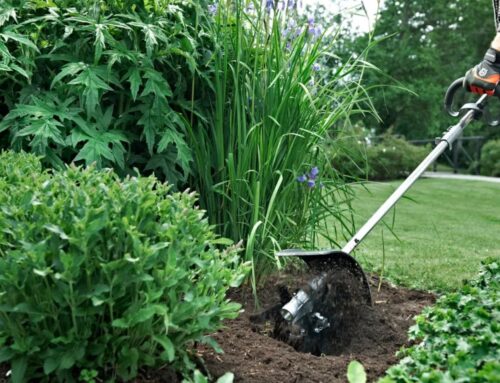
How to Look After Your Garden in a Heatwave
As Britain has been basking in a sweltering summer, gardeners up and down the country have been facing up to the challenges that come with hot weather. With several heatwaves already behind us and potentially more to come, if you’re going to maintain a thriving garden it isn’t just about watering more—it’s about gardening smarter.
From scorched lawns to wilting blooms, the heat can certainly take its toll. But don’t panic—there are plenty of ways to support your garden through prolonged dry spells and keep it looking lush, healthy and full of life. So, if you’ve been dealing with parched flowerbeds, stressed grass, or thirsty vegetable patches, it’s time to prepare for the next round of hot weather by considering how to protect your garden in a heatwave.
Rethink Your Watering Routine
 The temptation to water frequently during a heatwave is understandable, but less is often more. Plants benefit better from a deep soak than a quick sprinkle, so focus your efforts on saturating the soil around their roots. This encourages deeper root growth, helping plants become more resilient in the long run.
The temptation to water frequently during a heatwave is understandable, but less is often more. Plants benefit better from a deep soak than a quick sprinkle, so focus your efforts on saturating the soil around their roots. This encourages deeper root growth, helping plants become more resilient in the long run.
Water early in the morning or after your evening meal—never during the midday heat when the sun and evaporation are at their peaks. Avoid watering the leaves and flowers, especially under strong sunlight. Wet foliage can suffer from sun scorch, leading to browning and even disease. Instead, always direct the water towards the base of the plant. If time is tight, consider a drip irrigation system to deliver water slowly and directly where it’s needed most.
Mulch for Moisture Retention
 Mulching is one of the most effective defences against extreme temperatures. A layer of organic mulch—bark chips, straw, compost or shredded leaves—acts like an insulating blanket over your soil. It slows evaporation, keeps soil temperatures stable, and suppresses weeds that would otherwise compete for limited moisture.
Mulching is one of the most effective defences against extreme temperatures. A layer of organic mulch—bark chips, straw, compost or shredded leaves—acts like an insulating blanket over your soil. It slows evaporation, keeps soil temperatures stable, and suppresses weeds that would otherwise compete for limited moisture.
Aim for a mulch layer about 5cm thick, but be careful not to mound it directly against stems or trunks, as this can encourage rot. Not only will mulch help your plants survive the heat, but it will also improve soil quality over time as it breaks down.
Support Container Plants
 Pots are particularly vulnerable in a heatwave. The soil in containers heats up quickly and dries out much faster than garden beds. If you’re looking after plants in pots, move them to a shadier location such as under a tree, next to a north-facing wall, or beneath a pergola. This will help prevent heat stress and reduce how often they need watering.
Pots are particularly vulnerable in a heatwave. The soil in containers heats up quickly and dries out much faster than garden beds. If you’re looking after plants in pots, move them to a shadier location such as under a tree, next to a north-facing wall, or beneath a pergola. This will help prevent heat stress and reduce how often they need watering.
Lighter-coloured or ceramic containers retain less heat than black plastic ones, but if you’re stuck with heat-absorbing pots, try wrapping them in hessian or shade netting for extra insulation. Adding water-retentive gel granules to the compost can also help reduce watering frequency.
Looking After Grass in Summer
Your lawn may not look its best during a heatwave, but it’s more resilient than it appears. Most UK lawns are made up of hardy grass species that can cope with dry conditions better than you might think. That said, looking after grass in summer still requires a little care and adjustment.
 Raise the cutting height on your lawn mower and reduce mowing frequency. This helps retain moisture, reduces stress on the grass, and encourages deeper rooting. Cutting grass too short during dry spells leaves it exposed and more prone to sun damage.
Raise the cutting height on your lawn mower and reduce mowing frequency. This helps retain moisture, reduces stress on the grass, and encourages deeper rooting. Cutting grass too short during dry spells leaves it exposed and more prone to sun damage.
Weekly deep watering—if restrictions allow—is far more beneficial than doing it lightly daily. If the soil has hardened, spiking it with a garden fork will improve water penetration. Remember, even if your lawn turns brown on the surface, the roots remain alive, and it will usually recover after the first proper rainfall.
Avoid fertilisers and weed killers during hot spells too. These products can stress grass even further and may do more harm than good. If your grass is newly laid or sown, it will need much more attention, including daily watering until it becomes established.
Choose Plants That Thrive in Heat
 Planning ahead is a big part of successful gardening in hot weather. Drought-tolerant plants such as lavender, sea holly, and agapanthus naturally cope better with high temperatures and limited water. These species require less maintenance and will continue to add beauty to your garden.
Planning ahead is a big part of successful gardening in hot weather. Drought-tolerant plants such as lavender, sea holly, and agapanthus naturally cope better with high temperatures and limited water. These species require less maintenance and will continue to add beauty to your garden.
Try to group heat-loving plants together and place them in the sunniest parts of the garden. Save shadier or more protected spots for moisture-loving plants such as hydrangeas and acers, which may otherwise suffer in prolonged heat.
And if you’ve just returned from the garden centre with new purchases, wait until the evening to plant them. The cooler temperatures will reduce transplant shock. Also, giving them a generous drink after planting will help them settle in more comfortably.
Create Shade Where You Can
 Providing temporary shade can make a huge difference during extreme temperatures, especially for delicate plants or young seedlings. Use parasols, shade netting, or even old bedsheets, suspended above the plants to reduce sun intensity. For a more permanent solution, tall perennials, shrubs or even garden structures like pergolas can offer much-needed protection.
Providing temporary shade can make a huge difference during extreme temperatures, especially for delicate plants or young seedlings. Use parasols, shade netting, or even old bedsheets, suspended above the plants to reduce sun intensity. For a more permanent solution, tall perennials, shrubs or even garden structures like pergolas can offer much-needed protection.
Similarly, consider using your planting layout to create natural microclimates. Taller plants like sunflowers or tomatoes on trellises can shield more sensitive varieties beneath, while ground covers like creeping thyme can reduce soil temperature and prevent moisture loss.
Care for Wildlife Too
 Don’t forget the animals and insects that rely on your garden for food and shelter. In hot weather, wildlife can struggle just as much as your plants. Birds, bees, butterflies and hedgehogs need access to clean water, so keep bird baths topped up and place shallow dishes of water around your garden at ground level.
Don’t forget the animals and insects that rely on your garden for food and shelter. In hot weather, wildlife can struggle just as much as your plants. Birds, bees, butterflies and hedgehogs need access to clean water, so keep bird baths topped up and place shallow dishes of water around your garden at ground level.
Planting nectar-rich varieties such as honeysuckle, lavender and weigela will help pollinators find the energy they need.
Shaded areas, whether created naturally with plants or with garden structures, also offer a welcome respite to wildlife. Bug hotels, log piles and even upturned flowerpots can help small creatures find relief from the sun.
Reduce Stress and Avoid Overworking Your Garden
 During a heatwave, less is more. Hold off on pruning, transplanting or applying fertiliser, all of which place added demands on your plants when they’re already struggling. If you must prune damaged or scorched foliage, do it lightly and only to improve airflow.
During a heatwave, less is more. Hold off on pruning, transplanting or applying fertiliser, all of which place added demands on your plants when they’re already struggling. If you must prune damaged or scorched foliage, do it lightly and only to improve airflow.
Weeding, however, remains essential. Weeds not only look untidy but also compete with your plants for water and nutrients. Removing them during cooler parts of the day will help ensure your efforts are focused where they’re needed most.
Greenhouses, too, need attention. Open vents, add shade cloths or use shading paint to keep temperatures down. Misting the floor can help increase humidity and lower temperature.
Stay Sustainable with Water Use
 With hosepipe bans and water scarcity increasingly common, it’s important to make the most of the water you have. Install water butts to collect rainwater, and consider reusing household grey water—provided it’s free from harmful chemicals or detergents.
With hosepipe bans and water scarcity increasingly common, it’s important to make the most of the water you have. Install water butts to collect rainwater, and consider reusing household grey water—provided it’s free from harmful chemicals or detergents.
Water-saving measures like mulching, drip irrigation and strategic planting can drastically reduce your usage while still keeping your garden flourishing. In times of drought, prioritise the plants that need it most—usually young seedlings, shallow-rooted annuals, and any recent additions to the garden.
Keep Calm and Garden On
 Gardening in hot weather doesn’t have to be a losing battle. By adjusting your care routine, choosing plants wisely and creating the right conditions, you can help your garden stay green, vibrant and full of life—even when the heat is on.
Gardening in hot weather doesn’t have to be a losing battle. By adjusting your care routine, choosing plants wisely and creating the right conditions, you can help your garden stay green, vibrant and full of life—even when the heat is on.
As heatwaves become more common, knowing how to adapt is key to long-term success. Whether you’re looking after lawn in summer, nurturing a veggie patch or tending a vibrant flower bed, the right strategies can keep everything growing strong. Pay close attention to your garden’s needs, react early to signs of stress, and enjoy the warm weather knowing your outdoor space is equipped to thrive.
And—as always—if you need new tools or machinery to keep your garden looking its best this summer and beyond, you know where to come. From lawnmowers and strimmers to secateurs and hedge trimmers, the UK’s best online collection of garden tools and machinery is here.




